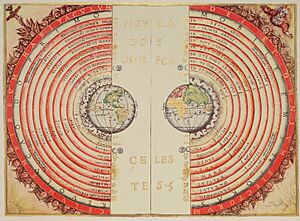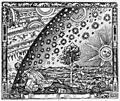History of the center of the Universe facts for kids

The center of the Universe is a very old idea. For a long time, people thought there was a special spot at the very middle of everything. But in modern astronomy, scientists believe the Universe doesn't actually have a single, distinct center. Instead, it's expanding everywhere at once!
Historically, different cultures and thinkers had many ideas about where the Universe's center might be. These ideas changed a lot as people learned more about space.
Contents
Early Ideas About the Universe's Center
For thousands of years, people looked up at the sky and tried to understand how the Universe worked. Their ideas were often based on what they could see and what their cultures believed.
Earth as the Center: The Geocentric Model
Many ancient cultures believed Earth was the center of everything. This idea is called the geocentric model. It meant that the Sun, Moon, planets, and stars all moved in circles around a stationary Earth.
- Ancient Beliefs: Some old stories talked about an "axis mundi" (world axis). This was like an imaginary pole connecting Earth to the heavens and other realms. Places like Mount Hermon or Mount Olympus were sometimes seen as this central point.
- Flat Earth: Before people knew Earth was round, many thought it was flat, like a disk. In a flat Earth model, there would be a clear center point.
- Spherical Earth: Later, thinkers like Aristotle (around 300 BC) realized Earth was a sphere. He noticed that different stars were visible from different places, and Earth's shadow on the Moon during an lunar eclipse was always round. Even with a round Earth, the idea that Earth was the center of the Universe continued for a very long time. Famous astronomers like Ptolemy developed detailed models of the Universe with Earth at its heart. This model was widely accepted for over 1,000 years.
The Sun Takes Center Stage: The Heliocentric Model
In the 16th century, a new idea began to change how people saw the Universe. This was the heliocentric model, which means "Sun-centered."
- Nicolaus Copernicus's Idea: Nicolaus Copernicus (a Polish astronomer) proposed that the Solar System actually revolved around the Sun, not Earth. He published his major book on this idea in 1543. His ideas weren't immediately accepted, but they started a huge shift in thinking.
- Kepler's Laws: Later, Johannes Kepler used careful observations to show that planets don't orbit the Sun in perfect circles, but in slightly stretched circles called ellipses.
- Galileo's Discoveries: Galileo Galilei used his new telescope in 1610. He saw that Jupiter had its own moons orbiting it. This was a big deal because it showed that not everything in the heavens orbited Earth. It helped prove that Earth was not the only special place with orbiting bodies.
- Isaac Newton's View: Even Isaac Newton (in the late 1600s) understood that the Sun wasn't the *exact* center of the Universe. He realized that everything in the Solar System, including the Sun, orbits a shared center of gravity.
Our Galaxy's Center
Before the 1920s, most astronomers thought our Milky Way galaxy was the entire Universe. So, if there was a center, it would be the center of our galaxy.
- Early Ideas About the Milky Way: In the 1700s, astronomers like Thomas Wright and Immanuel Kant suggested that the Milky Way was a huge collection of stars held together by gravity, spinning like a giant disk.
- Our Sun's Place: For a while, people thought our Sun was at the center of the Milky Way. But later, scientists realized that the Sun is actually quite far from the true center of our galaxy.
Why There's No Center of the Universe
The biggest changes in our understanding of the Universe came in the 20th century. Scientists discovered that our galaxy is just one of billions, and the Universe itself is expanding.
Discovering Other Galaxies
For a long time, fuzzy patches of light in the sky, called "nebulae," were thought to be clouds of gas and stars inside our Milky Way.
- The Great Debate: In 1920, there was a big discussion among astronomers about whether these "spiral nebulae" were part of our galaxy or separate "island Universes."
- Edwin Hubble's Proof: In 1925, Edwin Hubble used a powerful telescope to study the Andromeda Nebula. He found special stars called Cepheid variable stars in it, which allowed him to measure its distance. He proved that Andromeda was incredibly far away, much too far to be inside our Milky Way. This showed that Andromeda was a completely separate galaxy! This discovery changed everything. It meant our Universe was much, much bigger than anyone had imagined, filled with countless galaxies.
The Expanding Universe
Hubble made another huge discovery: he noticed that almost all other galaxies are moving away from us. The farther away a galaxy is, the faster it seems to be moving. This is called Hubble's law.
- No Special Place: At first, this might make it seem like Earth is at the center, with everything moving away from it. But scientists realized this isn't true. Imagine a balloon with dots on it. As you inflate the balloon, all the dots move farther away from each other. No single dot is the center of the balloon's surface.
- Space Itself Is Stretching: The Universe is expanding in a similar way. It's not that galaxies are moving *through* space, but that space itself is stretching, carrying the galaxies along with it. This means that no matter where you are in the Universe, you would see all other galaxies moving away from you. There is no special "center" point.
Modern Principles
Modern cosmology (the study of the Universe) is based on a few key ideas:
- The Copernican Principle: This idea, named after Copernicus, says that Earth (and our Solar System) is not in a special, central place in the Universe. We're just one small part of a vast cosmos.
- The Cosmological Principle: This expands on the Copernican principle. It states that the Universe looks pretty much the same everywhere and in every direction, if you look at it on a very large scale. A Universe that is the same everywhere and in all directions cannot have a single center.
So, in modern science, the Universe doesn't have a center. It's a vast, expanding space where every point can be considered equally important.
See also
- Cosmic microwave background
- Galactic Center
- Geocentric model
- Heliocentrism
- Solar System
Images for kids




